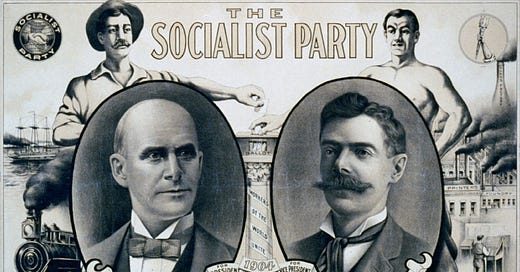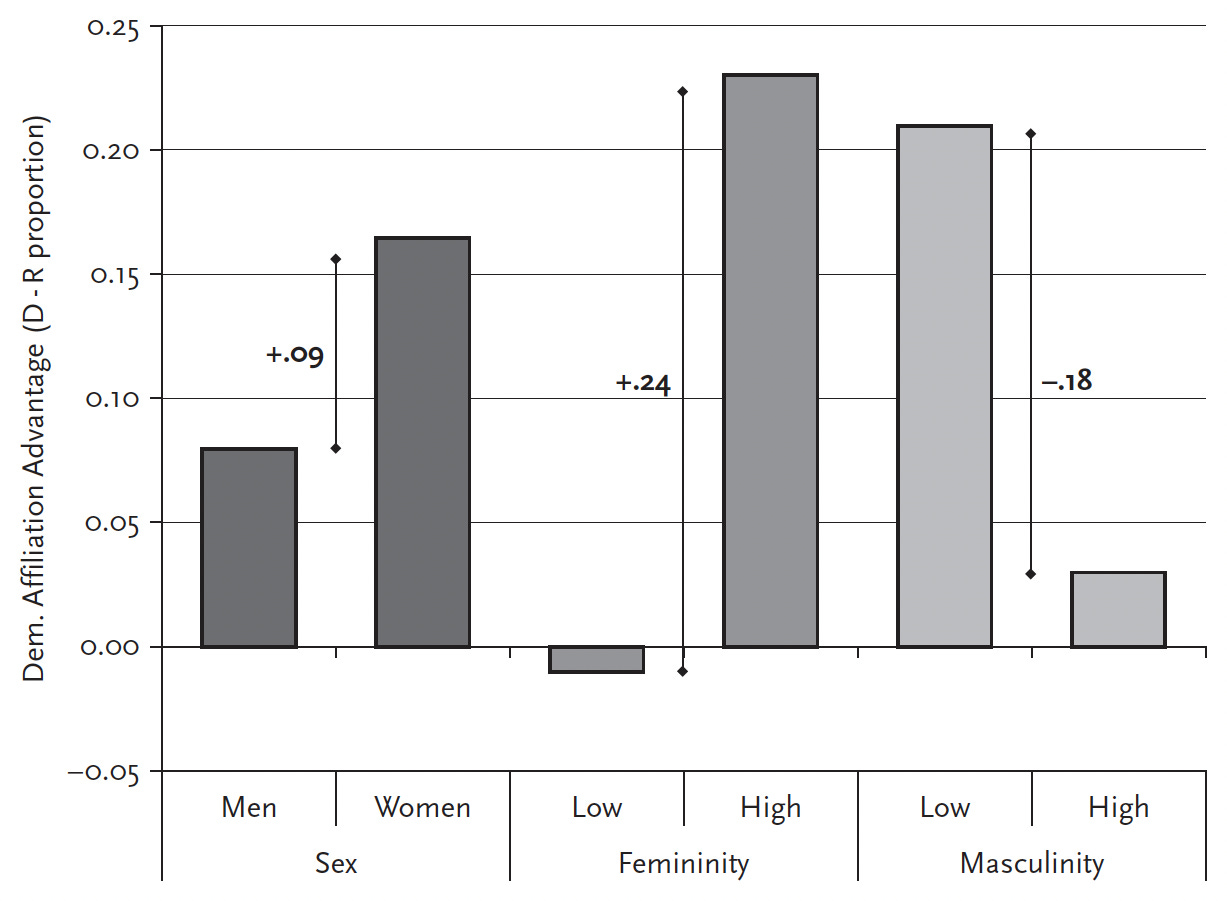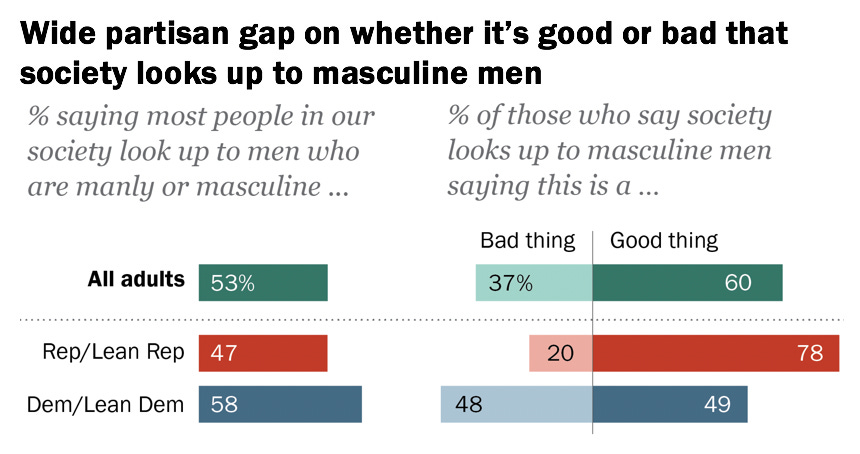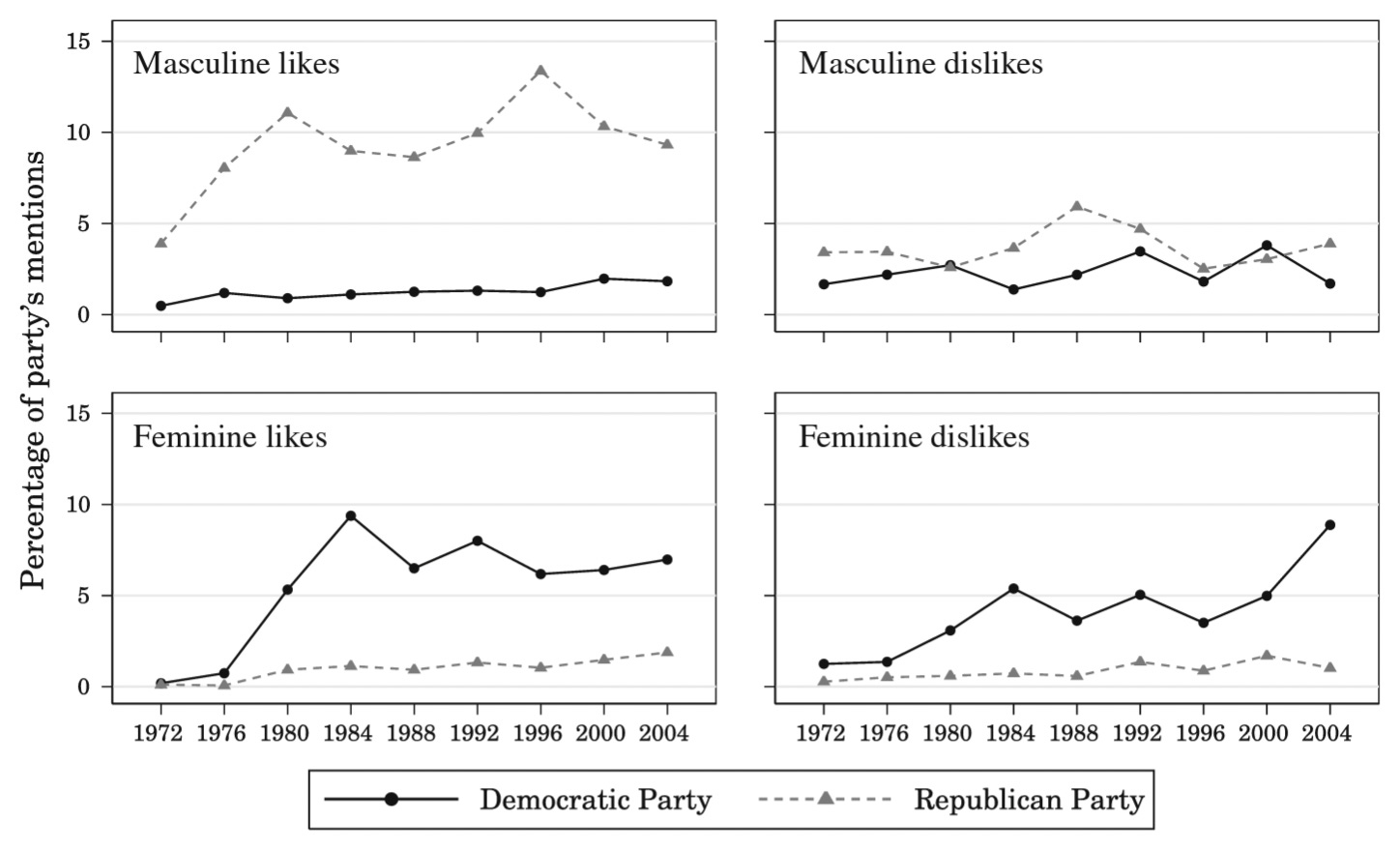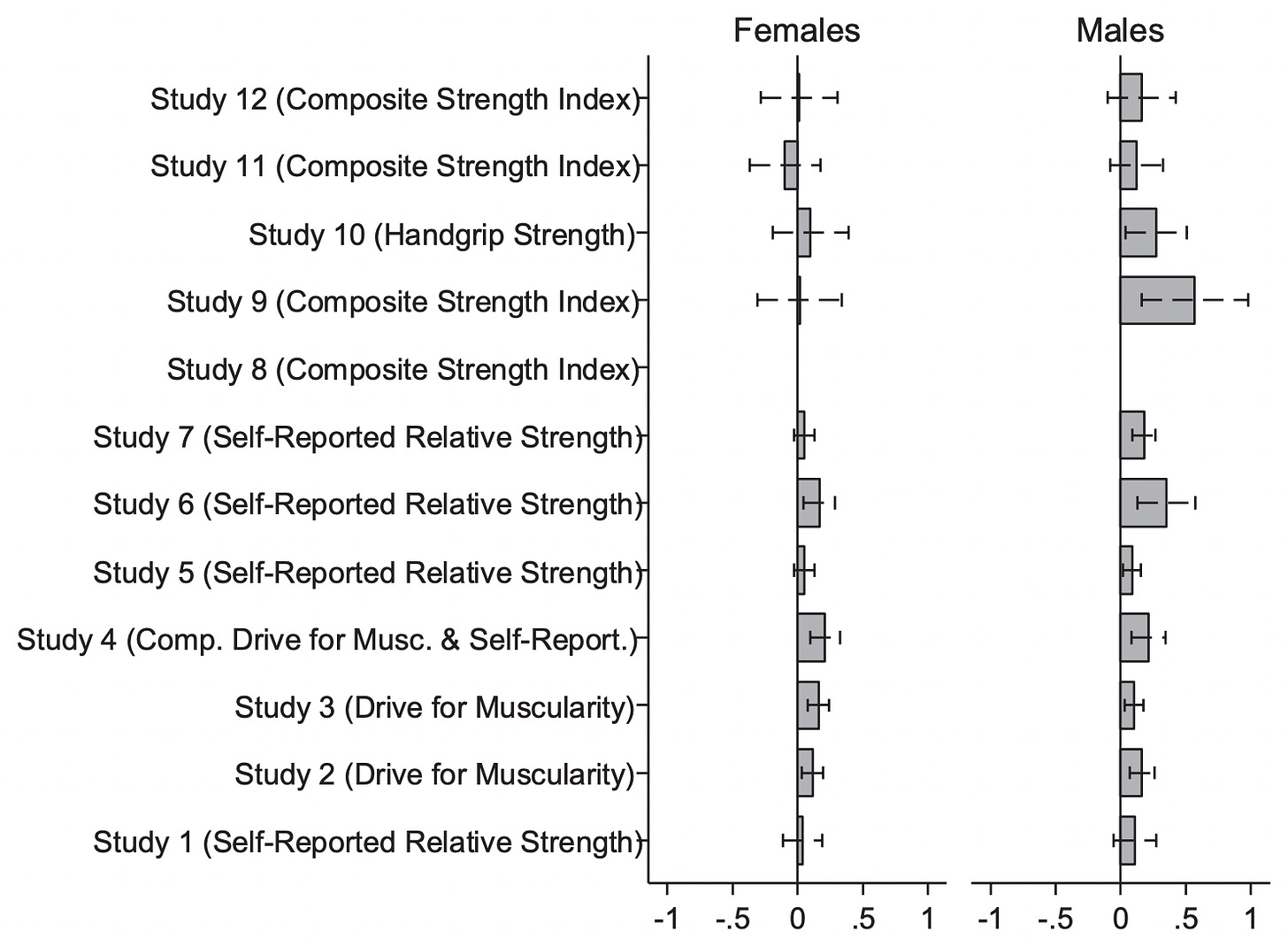The masculinity gap
Last year, I made a tweet that said the following:
The gap in masculinity between the left and the right seems to have widened over time. In the early 20th century, the left was as masculine as the right, or nearly so. Today, the right is unquestionably more masculine. What happened?
My tweet was accompanied by old election posters for Labour and the Socialist Party of America (see above) that portrayed distinctly masculine themes, such as men wearing military uniforms or performing industrial work. Needless to say, promotional materials for today’s left-wing parties (at least in the Anglosphere) tend to explore quite different themes. And if you ask contemporary left-wing pundits what “masculinity” is, they may tell you it’s something “toxic”, while simultaneously blaming everything on “straight white males”.
The question of why the masculinity gap has emerged is a fascinating one. But here I want to address something much simpler: evidence that the gap really exists. After all, not everyone was convinced by the rather sweeping claim in my original tweet. The remainder of this post reviews nine separate publications, covering several different methodologies, which all triangulate on the same conclusion: the right is more masculine than the left.
McDermott (2016). In her book Masculinity, Femininity, and American Political Behavior, the political scientist Monika McDermott studied the role of masculinity and femininity in contemporary US politics. She analysed data from the Gendered Personalities and Politics Survey, for which respondents completed the Bem Sex-Role Inventory. Specifically, they were asked to rate themselves on a number of traits, some of which are considered more masculine (e.g., forceful, dominant) and some of which are considered more feminine (e.g., tender, cheerful).
Based on respondents’ answers, McDermott created measures of masculine and feminine personalities. She then examined whether these measures were predictive of political attitudes, party identity and voting behaviour. One of her main findings is shown above. On the left-hand side, we see that the Democrats have a nine-point advantage over the Republicans among women. However, on the right-hand side, we see that this gender gap is dwarfed by the femininity and masculinity gaps. Democrats are 24 points more “feminine” than Republicans, and are 18 points less “masculine”. McDermott confirmed that these gaps persist when controlling for gender itself.
Pew Research (2017). In a 2017 survey, respondents were asked whether people in our society look up to men who are “manly or masculine”. Among those who answered “yes”, 78% of Republicans said this is a “good thing”, compared to only 49% of Democrats. And only 20% of Republicans said this is a “bad thing”, whereas 48% of Democrats said the same.
In the same survey, male respondents were asked whether they would describe themselves as “manly or masculine”. 39% of Republicans answered “very”, compared to only 23% of Democrats. And only 8% of Republicans answered “not at all”, whereas 21% of Democrats said the same.
Deckman and Cassese (2019). In a recent study, two political scientists analysed data from the 2016 White Working Class Survey, which asked respondents whether American society has grown “too soft and feminine”. They found that, in every social class, Republicans were much more likely than Democrats to answer in the affirmative. Interestingly, the largest gap was seen in the “upper-class”. (Class was based on self-identity.) Here, 85% of Republican men said that American society has grown “too soft and feminine”, compared to only 22% of Democratic men.
Winter (2010). In a 2010 study, the political scientist Nicholas Winter analysed data from multiple waves of the American National Election Study, which goes back to the 1970s. In each wave, respondents were asked to mention up to five things they like about each party, as well as up to five things they dislike. Their answers were then classified into three categories: masculine, feminine and neutral. “Masculine” answers were those that referred to traits or characteristics that are associated with masculinity in contemporary American society.
Winter’s main finding is shown in the graph above. Looking at the top two panels, respondents were more likely to associate the Republican Party with masculinity, especially when it came to things they liked about the party. This tendency appeared as early as the mid-1970s. Looking at the bottom two panels, respondents were more likely to associate the Democratic Party with femininity. And this tendency appeared in the early 1980s.
Robert and Utych (2019). In a recent study, two political scientists examined the use of gendered language in US presidents’ State of the Union speeches. They began by asking MTurk respondents to rate different words on a 1–7 scale from “very feminine” to “very masculine”. Among the seven hundred words in their database, those rated most masculine were: ‘man’, ‘jock’, ‘cocky’, ‘thug’ and ‘roughneck’. And those rated least masculine were: ‘woman’, ‘heroine’, ‘mistress’, ‘adorable’ and ‘sassy’.
The researchers then content-analysed US presidents’ State of the Union speeches to see whether Republicans or Democrats were more likely to use very masculine or very feminine words. They found that Democratic presidents were significantly less likely to use very masculine words, and this was true when controlling for whether the government was divided and whether the country was at war. Specifically, Democratic presidents used 2 fewer very masculine words per 1,000 words in a speech.
YouGov (2016). In a 2016 survey, British respondents were asked to rate themselves on 0–6 scale from “completely masculine” to “completely feminine”. 16% of Conservative supporters rated themselves “completely masculine”, compared to only 11% of Labour supporters. In the same survey, respondents were asked whether they have a positive or negative impression of masculinity. 20% of Conservative supporters said “very positive”, compared to only 7% of Labour supporters.
Coffé (2018). In a recent study, the political scientist Hilde Coffé analysed data from the Dutch LISS Household Panel, which includes items assessing masculinity and femininity based on the Bem Sex-Role Inventory (mentioned above). She found that respondents with masculine personalities were significantly more likely to vote for the Dutch right-wing nationalist party (the PVV), and this was true when controlling for gender itself. Those with the most masculine personalities were about 9 points more likely to vote PVV than those with the least masculine personalities.
Hatemi and colleagues (2011). In a 2011 study, researchers analysed data on individuals recruited from the Australian National Health and Medical Research Council Twin Register. Participants were asked to complete two measures of “gender non-conformity”. One measure referred to childhood, and one to adulthood. For example, the former asked, “In childhood, did you enjoy the occasional fistfight with another boy your own age?” Whereas the latter asked respondents to say whether they “feel very masculine”.
When both variables were included in the same model, individuals who scored higher on the adult measure of gender non-conformity were more likely to the support the Labour Party, over the right-wing Coalition. (The childhood measure did not have a significant effect.) Interestingly, this was true for both men and women. In other words, men who reported feeling less masculine, and women who reported feeling less feminine, were more likely to support the Labour Party.
Petersen and Laustsen (2018). In a recent study, two political scientists reviewed the literature on upper-body strength and political egalitarianism. Although not every study found a significant association, there was strong evidence that, overall, men with more upper-body strength tend to be less egalitarian. (No such tendency was evident among women.) The studies they reviewed covered multiple countries, as well as different measures of both upper-body strength and egalitarianism.
Their main finding is shown above. Each horizontal bar corresponds to the association between a measure of upper-body strength (give on the left-hand side) and social dominance orientation. The latter is a personality trait reflecting an individual’s support for social hierarchy, and is known to be associated with right-wing political views. Studies 1–7 were based on self-reported measures of upper-body strength; Studies 8–12 were based on objective measures. (Social dominance orientation was not measured in Study 8.)
The researchers also looked at the relationship between upper-body strength and economic conservatism. Of the five relevant studies, four found that men with greater upper-body strength tend to have significantly more economically conservative views. The fifth study found an association in the predicted direction, but it was not statistically significant. (There was no consistent association among women.)
In conclusion, there is substantial evidence, from multiple Western countries, that the right is more masculine than the left. This “masculinity gap”, I would conjecture, is relatively new. There may have been no such gap prior to the Great Realignment, when white-working class people began moving away from traditional left-wing parties. And its emergence may help to explain several phenomena, not least the left’s abandonment of free speech (support for which is a particularly masculine trait). In light of all this, the masculinity gap clearly warrants further study.
Image: Election poster for Eugene V. Debs, Socialist Party of America candidate for President, 1904
Free speech on social media
I wrote a piece for UnHerd about the UK government’s new Online Safety Bill. Here’s an excerpt:
We already have libel law to protect individuals from false claims that might damage their reputations. The notion that we need a law to protect them from false claims that might hurt their feelings borders on the absurd … What’s more, there actually is an effective way to neutralise malicious accounts on Twitter: it’s called the “Block” button. Other tried and tested methods for avoiding online abuse include looking away from the screen, and not joining Twitter in the first place.
The Daily Sceptic
I’ve written five more posts since last time. The first argues that Hayek’s speech ‘The Pretence of Knowledge’ applies jus as well to “The Science” of lockdowns as to the science of economics in the 1970s. The second plots age-adjusted excess mortality in England since January of 2020. The third summarises a recent study finding that early closure of bars and restaurants had no impact on the spread of Covid in Japan. The fourth outlines another question I’d like to ask Chris Whitty. The fifth argues that safetyism kills.
Thanks for reading. If you found this newsletter useful, please share it with your friends. And please consider subscribing if you haven’t done so already.

